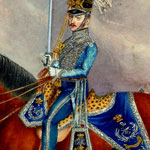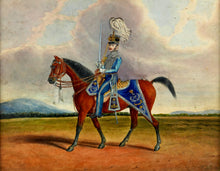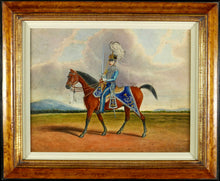Study of an Officer of the 2nd Madras Light Cavalry, 1845
- Regular price
- £1,150
- Sale price
- £1,150
- Regular price
-
- Unit price
- /per
Adding product to your cart
Measurements: Overall: 28cm (11in) x 33cm (13in)
Watercolour, pen and ink on paper. A English School study of a mounted officer in review order of the period circa 1845 when the officers’ headdress was changed from a Roman style helmet to an Albert pattern shako with large Maltese Cross plate and swan feather plume. Our officer’s uniform otherwise comprises French Grey full dress hussar jacket with pale buff facings, edged with silver Austrian pattern lace, ball buttons, the sleeves decorated Russia braid, silver laced shoulder belt, mounted on a chestnut charger equipped with a leopard skin saddle cloth, holder covers and shabraque with quarters pointed and edged with wide silver lace and embroidered with the crowned 2 M.L.C. cypher in silver lace, light cavalry pattern briddle with white horse hair throat plume. Framed and glazed.
Originally raised for the Nawab of Arcot's Army as the 3rd Regiment of Cavalry (Stevenson’s Pater’ ki Paltan), the unit transferred to British service in 1784 as the 3rd Madras Native Cavalry. it formed part of the force that defeated Hyder Ali during the Second Anglo-Mysore War and was awarded battle honours for the Sholinghur, Mysore, Carnatic and Seringapatam for service during the Anglo-Mysore Wars. In 1819 it was re-titled the 2nd Regiment of Madras Light Cavalry, and underwent a long period of inactivity until about 1880. The regiment later became the senior cavalry regiment of the Indian Army with precedent over all other cavalry regiments with the exception of the President’s Body Guard.






